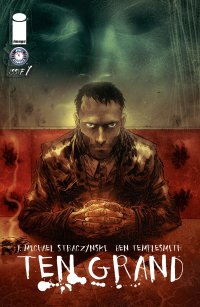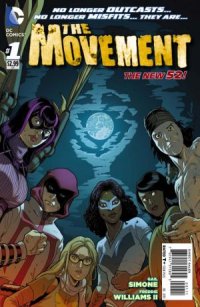Ten Grand #1 (Image, $2.99)
By Jeb D.
For the second week in a row, my affection for a particular artist’s work has trumped my misgivings about their writing partner: last week, Frank Quitely’s efforts on Jupiter’s Children got me to move to the positive side of my off again-on again relationship with the writing of Mark Millar, with generally favorable results; now Ben Templesmith has me once more taking a flyer on the work of J. Michael Straczynski, a writer about whom I’m generally pretty lukewarm, in this new title from JMS’ “Joe’s Comics” line. And, as with Jupiter’s Legacy, I found Ten Grand to be generally more satisfying than most of JMS’ stuff, even if I’m not completely bowled over yet.
Joe Fitzgerald is a Harry Blackstone / John Constantine-like private investigator, with one foot in the paranormal, and the other in a gritty “real” world. A young woman brings him a case that (whoda guessed?) ties into his dark, secret past, and sets in motion a storyline that will hit him very close to home.
That’s pretty much your setup, and while Straczynski’s not always good on the big picture (hopefully you’ve blanked “Original Sins” out of your memory, just like I have), here he’s typically excellent on the details: while Joe may not have the immediately entertaining personality of the brashly funny Constantine (he’s more your typical taciturn PI, who snarls at clients and only reveals his feelings in internal monologue), his use of the tools of the trade (things like mystic firewalls for doing online research into supernatural subjects) is well thought-out, and does a good job of grounding the story’s more fantastic elements. There’s a sense, though, that Straczynski’s tossing a lot of “classic” hard-boiled stuff into the mix just because he thinks it should be there: the young woman who approaches Joe remarks that she’d always heard he was funny, when that really isn’t part of his personality (to this point, anyway, he shows no signs of being in the wiseass Constantine or Philip Marlowe mold), and Joe’s stunned, somewhat terrified reaction to her revelation that the new case will revolve around someone that he thought was already dead is typical of detective stories, but in this context, it seems pretty extreme, coming from a guy who deals with angels and demons on a regular basis.
Speaking of such extra-earthly beings, Templesmith was the perfect choice to illustrate this comic. He brings the urban seediness of the much-missed Fell to Joe’s world, and sprinkles it with horrors that make 30 Days of Night look mundane. It’s actually those hellish visions of Templesmith’s that push this over the top for me: this supernatural world doesn’t look quite like anyone else’s, and the monstrous beings we encounter aren’t just slavish reproductions of the latest FX designs out of a Clash of the Titans movie. Templesmith’s still better as an illustrator than a sequential storyteller, but with a script that moves as efficiently as Straczynski’s, that’s less of a problem, and the patina of dread and disease that Templesmith lays over the story drives home the tragedy at the heart of Joe’s life, adding some idiosyncrasy whenever the writing leans toward the generic.
Paranormal procedurals can be tricky to pull off, since a mystery story is typically most satisfying when the impossible becomes the inevitable, and Joe seems to be operating in a universe where not much seems “impossible” in the first place. But even if JMS fails to completely stick the landing (or even finish the thing), as has been the case with previous books like Rising Stars, Squadron Supreme, and Midnight Nation, he and Templesmith promise that it’ll be an engaging ride along the way.
Rating: 




Out of a Possible 5 Stars
 Mr. X: Eviction #1 ($3.99, Dark Horse)
Mr. X: Eviction #1 ($3.99, Dark Horse)
by D.S. Randlett (@dsrandlett)
Every comic company has the same favorite lie: “Perfect jumping on point for new readers.”
Dean Motter’s Mr. X has been around for a while, but I’ve only ever known it by reputation. Something Dark Horse has gotten very good at recently is corralling great indie comics creators to produce new material for a broader market. Sometimes it comes in the form of brand new stories, like Gilbert Hernandez’s Kirby-esque Fatima, or continuations of older series, like Mr. X. In the former case, you get a great window into a creator who might be new to you (and an excuse to hunt down earlier, now classic work), while the case of the latter might leave you wondering what all of the fuss is about. For publisher and reader both, it is a risk.
This new Dark Horse publication of Mr. X, by virtue of containing two different stories, directs that risk in both positive and negative directions. After reading the first story (the first part in a three part series, and the “A” story here), I was ready to give this book a middling review. I had, after all, been lied to. In this first story, we are obviously picking up a thread of a continuing story. There are allusions to an upended status quo, and some assumption of familiarity with this world and the principle characters. It is, obviously, unfair to denounce this book on those grounds as it is Writer/Artist Dean Motter’s absolute right to assume familiarity with his past work. If this is your first exposure to the world of Mr. X, this first story is simply impossible to really engage with, despite Motter’s sense of style and deft use of allusion. Once estranged from his work, it’s easy to pigeonhole the story’s sensibilities as derivative of something like League of Extraordinary Gentlemen mashed up with Batman Adventures.
So, if you’re new to this series: start with this book’s second story. It is a more or less stand alone adventure featuring a unique crime involving civil engineering, but more importantly it gets across just what Mr. X is all about, to the point that the first story is able to be engaged with. Once engaged with Motter’s work and world, it comes off less as a hodgepodge of influences, and more like the directed use of Motter’s influences to talk about the things that interest him. The second story makes it clear: these are stories about cities and how they change people, and how people find purpose in them.
What stands out is Motter’s design sensibility, informed by the architecture of silent German films. This lends a fitting noir sensibility to these crime stories, but it also reinforces the key conflicts presented in them: the struggle between identity and conformity, order and chaos. Unfortunately, none of these thematic elements are ever really paid off here, and in that way it is very much a first issue. Still, it is the opportunity to be exposed to a reputed talent and to see that talent at play, and that is always a risk worth taking.
Rating: 




Out of a Possible 5 Stars
FURY MAX TP VOL 1 (Marvel Comics, $16.99)
By Devon Sanders (@devonsanders)
America is in love with a man who never quite shows his hand. A man apart.
From Bruce Wayne to James Bond to Don Draper, we love absolutely love a guy whose aware of his presence; a man who knows the value of a secret.
And no one; no man, no woman, knows the value of a secret like Marvel Comics’ Nick Fury. No one especially knows the value of Nick Fury’s secrets like Nick Fury.
To know Nick Fury’s secrets is to know America’s secrets, its values and the compromises made in defending them.
Garth Ennis’ Fury MAX opens with a much older Nick Fury, filling his days much as he had in his youth; with liquor and women. The Fury of the future is a man whose adventures grow fewer and farther in-between. Fury recalls tales of The Cold War and Americans and her soldiers flush with victory not horribly long after World War II and Korean War. This is a Nick Fury who may never fight side-by-side with gods or once again, defend America with The Star-Spangled Avenger. This is a soldier. In bloodied fields, a lone French Indochine general will show him the type of man he will have to become. He will become this man and it is fascinating.
The brilliance of writer Garth Ennis’ Fury is that he’s very much the man we know now and yet, not. Ennis gives Fury the room to know failure; to make mistakes. This Cold War Fury will become involved in The Bay of Pigs, he’s seen what Vietnam will become and quietly knows more and more the type of men this world will need. Ennis’ Fury truly is a man; a man baptized in blood and very in tune with the deafening truth of secrets.
The true star of this mini-series is artist Goran Parlov. Parlov’s art perfectly captures this tale’s dark realism. Nothing in his art is exaggerated; every line and shadow, necessary. Mood is king here and Parlov displays expertly the style of dress and more importantly, how the men and women of the era carried themselves. They knew who they were. Parlov is an artist I always look forward to seeing more from.
Fury MAX is a truly unflinching look at the making of a man; past, present and future.
Rating: 




Out of a Possible 5 Stars
 The Movement #1 (DC, $2.99)
The Movement #1 (DC, $2.99)
By Adam Prosser
Superhero comics are no place for politics.
Naaaah, that’s a load of garbage. The earliest Superman comics were pretty brazenly, unapologetically political, as Supes took on exploitative businessmen, corrupt politicos, and eventually, famously, the Ku Klux Klan. Superheroes all joined in with the fight against the Nazis, though that’s less of a bold political statement than it is a “no duh” moment. Later, Marvel embraced politics, with its early communist-baiting morphing into relatively hard-hitting looks at social ills like racism and drug addiction. Then there’s Green Lantern/Green Arrow, Watchmen, cold war commentary in Giffen/DeMatteis’s Justice League International, the often tacky shock value of the early Image comics gang…If anything, it kind of seems like the current crop of superhero comics are unusually detached from politics, historically speaking.
DC’s The Movement #1 aims to change that. Written by Gail Simone and drawn by Freddie E. Williams, the series presents a so-far mysterious but apparently street-level organization who wears masks to remain anonymous while recording incidents of police corruption. Though this group, known as Channel M as well as the titular Movement, seems to be comprised of a vast group of people who could be just about anyone, it seems to be spearheaded by a group of superheroes with a specific agenda. The leader, “Virtue”, lays it out to the chief of police, while claiming the “Tweens”, a violent neighbourhood in Coral City, as their territory: “Don’t be too proud of your prisons. You might end up there yourself one day.”
This whole concept is so obvious it’s almost a gimme: one of the most dramatic impacts comics have had on the real world of late is in the form of V For Vendetta‘s iconic mask being appropriated by “Anonymous”, so why not steal it back, conceptually, for a comic book? Hell, DC published V For Vendetta in the first place–I’m kind of surprised they were able to resist the temptation to make the Movement a literal V For Vendetta sequel. (Except, if the Movement wore Guy Fawkes masks, they probably would have been inspired by the comic, which would make it kind of a meta-sequel?) As many problems as I have with the movie adaptation of V For Vendetta, there’s no denying that the final images, of an enormous crowd donning V masks to help bring down a repressive government, is a powerful one, a moment where the ridiculous fantasy of superheroes suddenly starts to seem weirdly connected to the real world. The ramifications are fascinating, and dealing with them in the form of a superhero comic isn’t just logical, it seems like the only real genre that could tackle it properly.
That said, there are a LOT of pitfalls this book could potentially fall into. For a start, the Movement’s main target so far is police brutality; the opening scene has two fascist cops being captured on video by Movement members, reflecting the increasing evidence of official corruption and abuse that get captured by citizen watchdogs across the globe. And that’s fine, but if Simone’s main inspiration is the Occupy movement and Anonymous, then there’s a slight danger of misrepresentation here, and it’s crucial: Occupy’s main target isn’t police or governmental corruption or abuse per se, it’s the infamous “1%” (actually more like 0.01%) who seem to be clenching their fist ever tighter on our civic institutions. Corruption and abuse are merely the <i>results</i> of that process, and to focus our attention onto the enforcers of the status quo rather than the people behind it runs a danger of muddying the issue. Since the Occupy movement (which by the way, still exists, not that you’d know it from the kind of media attention it gets) came into being, it’s been misrepresented, sometimes combatively (“rapists”, declares a well-known comics creator who thinks the ancient Spartans were awesome, heterosexual defenders of liberty), sometimes more subtly as radical communists or anarchists. And sometimes even the well-meaning can fall into this trap, by falling back into easily commodified fight-the-power tropes.
It’s this latter that concerns me somewhat about this book–after all, how many stories have we seen about eeeeeeevil corporations that were, themselves, published by evil corporations?
Still, these are potentialities rather than specific problems with The Movement #1 as it actually exists. And as a first issue, it’s quite well done, hanging a series of distinct personalities on a compelling concept. Simone is certainly smart enough not to assume that people will be interested enough in her Big Ideas and a few random fight scenes to buy the book; she makes a solid case for why we should care about these so-far mysterious lead characters even though they only appear on a few pages. In fact, this issue is largely from the perspective of Coral City’s police commissioner, a man who could just as easily be an antagonist as an ally (and in fact seems to be leaning more towards the former) but is nevertheless painted as a nuanced human being. Simone’s been doing this long enough to know her craft, but unlike some of the paycheck-grabbers who have hung on at the Big Two too long, she still seems engaged, with this story at least. Even if you could somehow extract the politics, this would be a very solid first issue of a superhero story.
But of course, the politics are inextricably bound up with the nature of this book, and exactly what Simone chooses to say with it will have a massive impact on its quality, regardless of how entertaining it remains on every other level. Right now, this comic is walking a razor’s edge, and it could fall off with the very next issue. For now, though, this is the first really interesting comic DC’s published since The New 52 broke, and a possible glimmer of hope that we might get more superhero comics with something to say.
Rating: 




Out of a Possible 5 Stars